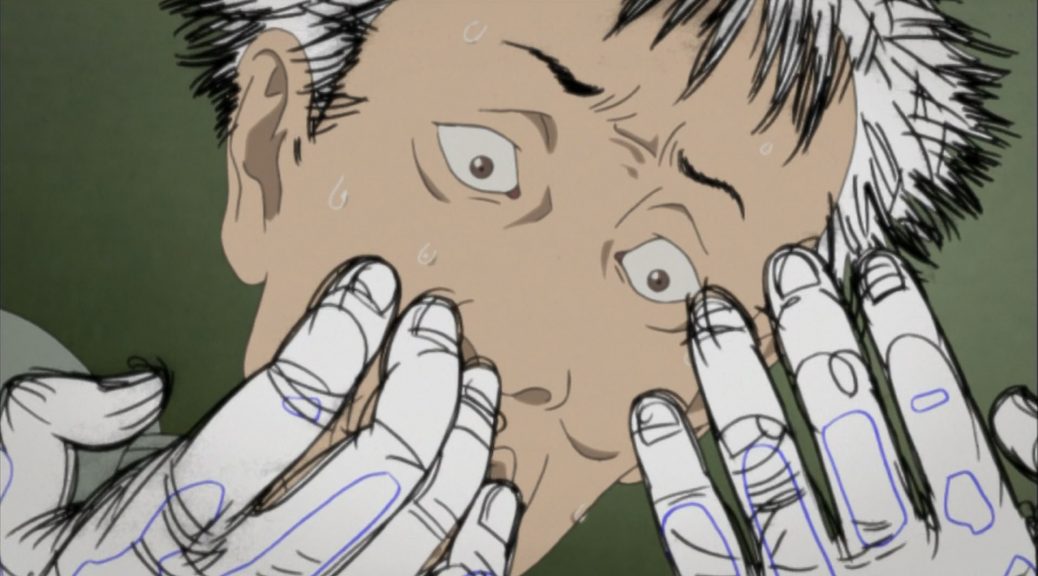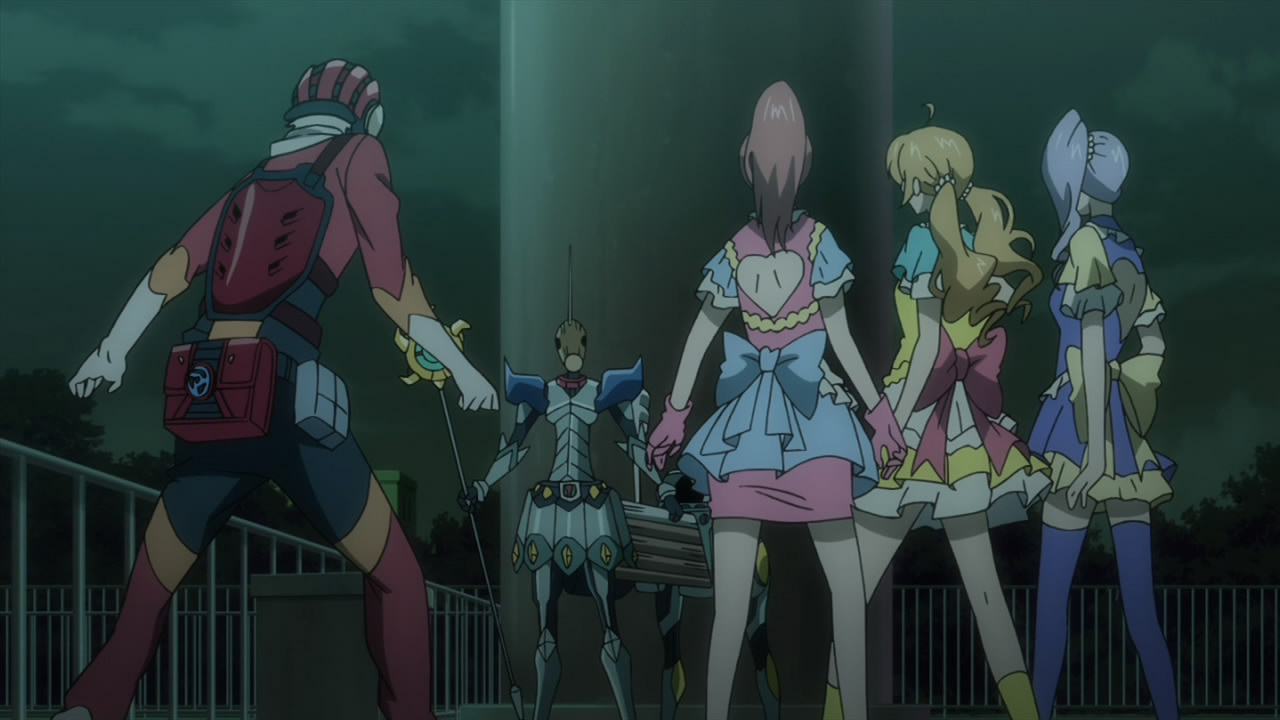Director: Satoshi Kon
Screenplay: Seishi Minakami and
Tomomi Yoshino
Voice Cast: Daisuke Sakaguchi as Shonen Bat; Mamiko Noto as Tsukiko Sagi; Halko
Momoi as Maromi; Makoto Tsumura as
Shogo Ushiyama; Ryūji Saikachi as Old
Person; Shōzō Iizuka as Keiichi Ikari; Toshihiko Nakajima as Masami Hirukawa; Toshihiko
Seki as Detective Maniwa
Viewed
in Japanese with English Subtitles
Synopsis: One night a female illustrator Tsukiko Sagi is assaulted
by whom she describes as a young male wearing golden inline skates with a bent,
golden baseball bat. Thus "Lil' Slugger" (or Shonen Bat in the
original Japanese) is christened, and to the police's bafflement, he can
abruptly appear to all his targets, all of which are seemingly people either
connected to each other and/or pushed to the edge of despair.
In his short and tragically short
career, only living to forty six due to pancreatic cancer, Satoshi Kon made four films and this one anime series, but has
developed a cult reputation that has even stepped outside of anime itself. When
being in your forties is still considered a young upstart in the anime
industry, Kon could've (and likely)
would've pushed the medium of anime into more idiosyncratic directions. Based
around various strands of ideas he felt shouldn't be wasted, what Paranoia Agent is isn't necessarily vignettes
but all tied into a very elaborate thirteen episode series. Contrary to my
original beliefs, such a long time since seeing this series, Paranoia Agent is a very precise tale.
Ten episodes follow the tale of Lil'
Slugger, an urban legend who yet is actually responsible for smashing people in
the skull with a golden baseball bat, strangely targeting people all
interlinked by them reaching a crisis point in their lives. The three episodes
which feel like side plots, the entirety of disc three of the original UK DVD
release, back when anime used to be (inexplicably) released by three or four
episodes over many months, are still connected to the main story and add
character to the world being depicted.
In said world, as his other work,
Kon blurred reality itself with the
exception of Tokyo Godfathers (2003),
tackling subjects like dreams or subjectivity under mental distress. Even when Paranoia Agent can only work as being
supernatural for certain plot incidents, it's using a lot of visual metaphors
to depict the distorting mental states of its cast. Flights into an idolised
youth, literally a cardboard town of two dimensional people, a woman whose
split personality in combat with her leaves answering machine messages, a
police interview which (in the funniest episode) turns into a stereotypical
Western high fantasy quest based on delusions of being in a video game, or the
first victim of Lil' Slugger, character illustrator Tsukiko Sagi, having her
mascot character Maromi as a talking figure who constantly tells her to just
ignore any prang of concern she has about anything.
Ultimately, Kon emphasises a long trodden obsession of his of the absolute
dangers of escaping reality no matter how painful it is, one of the only
exceptions being Millennium Actress
(2001), a tale of an aging actress which was clearly indebted to real life
Japanese actresses Setsuko Hara and Hideko Takamine. Here in Paranoia Agent is his most overt thesis
of this concern as it's the central plot. Following intertwined characters - Sagi,
two cops Keiichi Ikari (older and old fashioned) and Mitsuhiro Maniwa (younger
and dangerously open minded), and various reoccurring side characters - the
tale of Lil' Slugger, at first seen merely as a hoodlum, is visibly even in the
subjective world view of the series a supernatural entity or one giant metaphor
for escape that has become an actual, real destructive force. He targets those pleading
to escape pain - neurosis, anxiety, a downward spiral of crime, general chaos
in one's life - called in hope he'll roll in on golden inline skates and in one
case knock someone's skull in so hard they completely forget who they are and
all they've suffered through.
 |
| From https://i0.wp.com/the-avocado.org/wp-content/uploads/ 2018/02/PA12_shot4.png?zoom=2.625&resize=371%2C173&ssl=1 |
Not desiring to spoil the series, his mirror is Maromi, that lovable cartoon dog that Tsukiko Sagi created at the beginning of the series, a stand-in to a phenomenon like Hello Kitty who is an immediate success and becomes an insanely huge marketing property that the populous becomes obsessed with. We'll get to Susumu Hirasawa's music later, but it's not a surprise in lieu to how sinister this dog's influence is, at least in Kon's eye, that the end credits has every character laid asleep around a giant version of Maromi, in a grassy field, whilst an unnervingly calm but eerie piece of music is playing.
The series also an attempt at
tackling various cultural issues; Kon's
work all did, Tokyo Godfather
breaking a taboo by talking about the homeless in Japan, but Paranoia Agent is basically sewing
together various different issues at once through one long form project. The
anime obsessed otaku, a minor side character, who in the gaze of all his female
figurines hires a sex worker. The gossiping women, who have an episode, trying
to have more elaborate tales about Lil' Slugger over the others. The episode on
suicide, as three members of an online forum for this act meet up, an elderly
man and a young man horrified the third in a young girl.* The general sense,
coming to ahead in the finale, of a collective attempt to bury one's emotions
that becomes completely destructive.
In lieu to how TV anime is likely
more hectic to produce and with less time to manage resources, Paranoia Agent is still a great series
in terms of craft, even with a sense of humour at the expensive of this area of
the medium being incredibly stressful as, for an episode, it follows a lowly
and useless staff member on an upcoming Maromi animated show, explaining
various details of real staff member positions in digressions and probably
touching on some real angst, being let out, of how utterly agonising working on
a show production schedule probably is. Kon
is also a fascinating case where, an absolute definition of an
"auteur" where his directorial work bares his obsessions, he also
shows how many auteurs how important voices working under them who don't negate
their status as directors, but are great collaborators. Character designer Masashi Ando, who worked on him on Tokyo Godfather and his last film Paprika (2006), has helped a lot in
terms of the trademark realistic character designs which have allowed a
grounded sense of reality to these works, perfect for when they transition into
the unnatural.
Likewise is his frequent musical
collaborator Susumu Hirasawa, who
started working with Kon fron Millennium Actress and, alongside his
work in anime like the soundtracks for the various Berserk adaptations, is likely better known through them than his musical
albums in the West. This is sad, but not a detrimental argument against said
soundtracks, Paranoia Agent just as
compelling. The best way to describe him is Peter
Gabriel's soundtrack to Birdy (1984)
crossed with New Age and electronic pop, folk ideas matched with all the
peculiar electronic equipment he has had on stage over the years, all matched
by a falsetto to die for. That, and I swear to this, even yodelling or the
closest thing to it. Seeing his work in a TV series, whilst it does repeat
motifs, is a very interesting change of pace, even an amusing choice of using
the opening theme within an episode to freak a character out. And befittingly,
whilst it's joyful, the lyrics in translation are aptly dark and for
consideration alongside the opening credits animation itself, held with high
regard as an opening itself by a puzzle box to decipher. Even the next episode
previews, including a side character of an old man who is presumed to be delusional
but has a strange knowledge, add to this by using animal nicknames for
characters for part nonsense, part clue based monologues.
Sadly, this was Satoshi Kon's only television series,
but among his small output, Paranoia
Agent stands out as also one of the best series from the 2000s with good
cause. Arguably, with a career that beforehand included being a manga author
and working up in the anime industry itself to also consider, Kon had one of the best runs as a
director regardless of medium, four films and one series which are as high a
bar in talent as you could get. Again, its stepped in tragedy and loss, but God
he was good.
 |
| From https://blog.sakugabooru.com/wp-content/ uploads/2017/12/tfw-houkai-1038x576.jpg |
======
* Unfortunately, within the UK,
whilst the offending scene is seen in the next episode preview beforehand, that
episode was censored for a hanging scene and is still like this in 2019. At the
same time, when this took place, an episode of Ren & Stimpy was censored for a gag about hanging too for DVD;
despite Paranoia Agent being an adult work still rated for only eighteen year
olds to see due to this episode, I have always speculated that it was picked on
as well for being animated and depicting a form of suicide as well. It's still
one of the biggest reasons, despite all their good virtues, I have always had a
distrust of the British Board of Film
Classification (BBFC) where every motion media work has to be rated
through.








